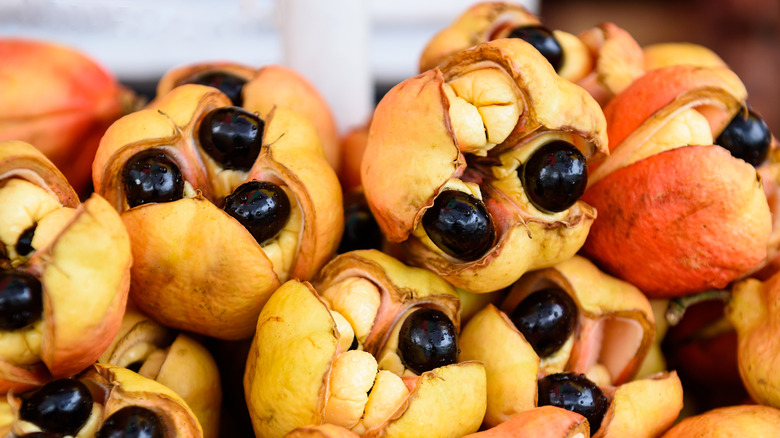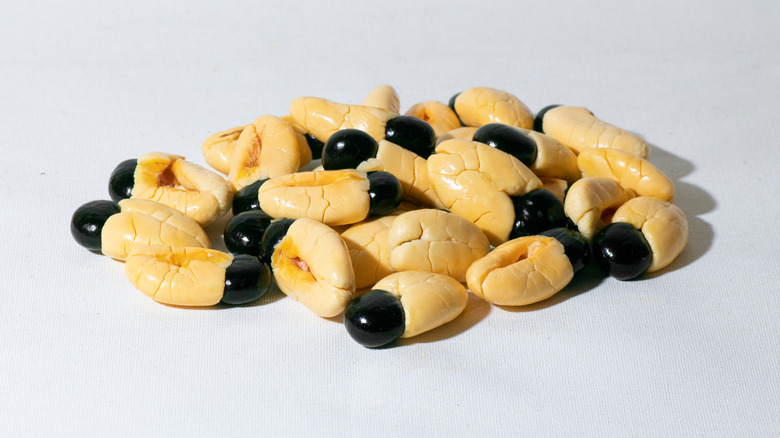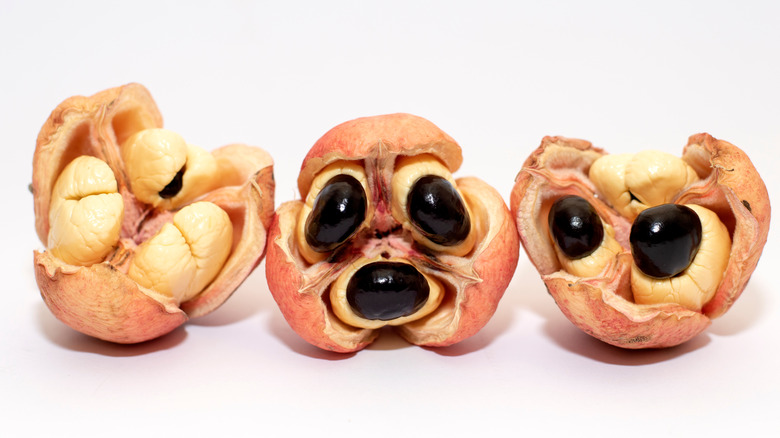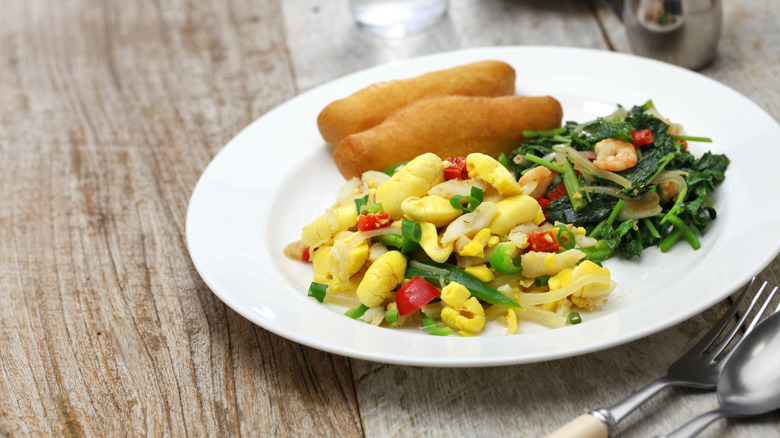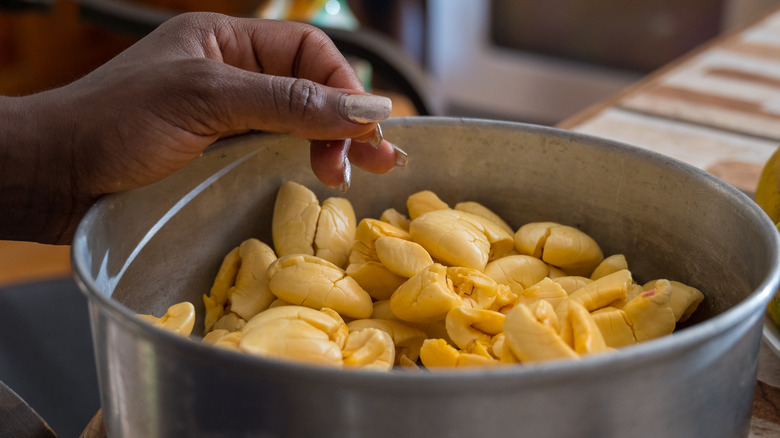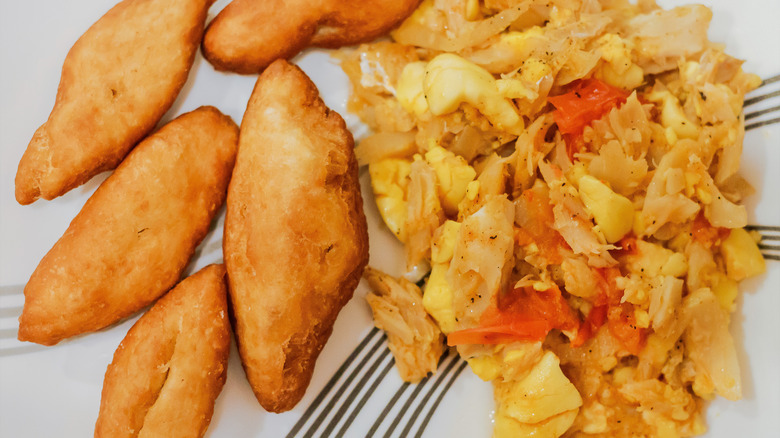What Is Ackee And What Does It Taste Like?
Have you ever tasted ackee? If you've ever been to the Caribbean, particularly the island of Jamaica, you may have sampled this produce item that tastes like a starch but is actually a tropical fruit. Native to West Africa, ackee landed in Jamaica in the late 18th century as a result of the slave trade (via The Atlantic). The fruit became an integral part of the local diet and is now widely cultivated across the island, where it grows on evergreen trees and is available year-round.
Over the centuries, ackee has become so revered in Jamaica that it is now known as the national fruit (via Jamaica Information Service). It is also the primary ingredient in the country's treasured national dish and traditional breakfast, ackee and saltfish. There's much more to know about this unusual but tasty Jamaican food that looks like a nut and tastes like whatever you use to season it.
What is ackee?
Ackee, or blighia sapida, is related to lychee, those small, sweet fruits with a spiky outer peel. But in taste and appearance, ackee couldn't be more different. About the size and shape of a large pear, but with ridges all around, ackee fruits take on a rosy coral color as they mature on the tree. When the fruit is ripe, its pod will split and open up, known as "smiling" or "yawning," indicating that it is ready to be consumed (via The Spruce Eats). When the ackee opens up, inside you'll find three or four cream-colored sections of flesh, each with a glossy, black seed at the end of it. These light-hued sections are the part of the fruit that is edible.
It's important to know that ackee seeds are highly toxic, and the flesh, too, can be toxic if it is eaten before it ripens. Improperly or hastily prepared ackee has continued to sicken and even kill people as recently as the 2010s, reports the Jamaica Observer. The illness caused by eating tainted ackee fruit is popularly called Jamaican vomiting sickness and can lead to coma and death. That being said, properly cleaned and prepared ackee poses no risk and is consumed with gusto across the Caribbean.
What does ackee taste like?
There's no other way to say it: Ackee is sort of a weird fruit. Although it's related to lychees and looks like it would be sweet, ackee is much more vegetal in taste, even approaching a starchy type of flavor and mouthfeel. When chopped and cooked, ackee actually resembles scrambled eggs in pale yellow color and creamy, delicate texture, though its mild, savory flavor is often compared to nuts like almonds or legumes such as chickpeas.
As mentioned above, the seeds of the ackee fruit are highly poisonous, and ackee flesh can be dangerous if it is eaten before it's ripe. That's why in the United States, only canned, pre-prepared ackee is available (via The Paris Review). When working with the fresh fruit, you should remove the seed from each section of flesh and discard the outer pink skin. Then, you'll rinse off the flesh and be ready to cook it. The dishes you'll be able to make may surprise you.
How to cook with ackee
Across the Caribbean and especially in Jamaica, where the fruit is most widely consumed, the word "ackee" is almost always followed by the phrase "and saltfish." Ackee and saltfish is Jamaica's national dish and one of the most widely available breakfasts you will find on the island. A mix of cleaned ackee flesh, reconstituted dried salt cod, and produce including sautéed onion, bell pepper, tomato, and fiery Scotch bonnet chiles, the dish is typically accompanied by slices of starchy breadfruit, fried balls of dough, and boiled or fried bananas or plantains.
It's also common to make a quick ackee batter with flour, egg, onion, and seasonings to make round or flat ackee fritters. In West African countries such as Senegal and Cameroon, it is often cooked into soups; its soft texture makes it easy to blend into a creamy consistency. Those new to cooking with canned ackee will have an easy time using it as a vegan substitute for scrambled eggs or taco meat. Finally, the versatile texture of ackee makes it a good candidate for custardy desserts such as cheesecake. For more ideas, check out food blog Ackee Adventures.
Where to buy ackee
Though ackee is grown widely across Jamaica and neighboring Caribbean islands such as Trinidad, Haiti, and the Bahamas, it is not cultivated in any significant quantity in the United States except for in the lone state of Florida (via the University of Florida). Because of the slight risk of toxicity of ackee, the Food and Drug Administration has banned the import of the fresh fruit. Therefore, the vast majority of ackee available for consumption here is processed and canned in the Caribbean, mostly in Jamaica, and then exported to the U.S. (via Science Direct).
Canned ackee is not something you'll find at most Walmart or Whole Foods stores, but it will pop up occasionally at African and Caribbean grocery stores in major cities, especially those with a significant Caribbean population, such as New York. It is also available online, of course. If you manage to get your hands on canned ackee, know that the fruit is already fully cooked — just drain the brine before you get to work stirring up some ackee and saltfish.
Nutritional information about ackee
Jamaicans get a large percentage of their fatty acid intake from ackee, which contains an especially concentrated amount of linoleic acid, according to the University of the West Indies. Linoleic acid is a safer alternative to saturated fats and may improve heart health and blood pressure, says the Harvard T.H. Chan School of Public Health. Additionally, a 3.5-ounce serving of the tropical fruit contains 151 calories, 9.5 grams of carbohydrates, and 30 milligrams of vitamin C, according to Livestrong. Ackee is also high in niacin, or vitamin B3, which may help lower cholesterol, Healthline says.
When you eat ackee, you'll load up on potassium, an important electrolyte that helps regulate blood pressure and lowers your risk of stroke (via Live Science); phosphorus, a mineral that helps your kidneys filter waste and your muscles recover after exercise, reports Healthline; and calcium, another mineral essential for maintaining bone health, the National Institutes of Health says. Finally, ackee has no saturated fat or cholesterol, so it's a code-green ingredient if you're avoiding those in your diet. Since this ingredient is so versatile, you should have no problem pairing it with whatever foods best fit your lifestyle.
